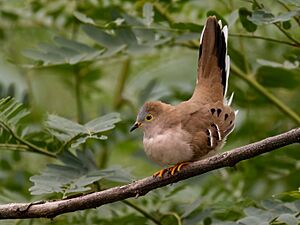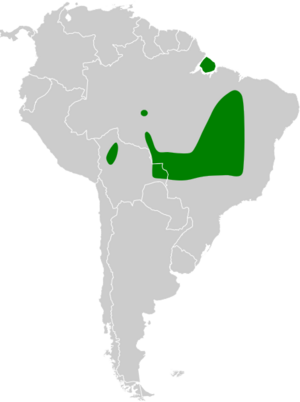Long-tailed ground dove facts for kids
Quick facts for kids Long-tailed ground dove |
|
|---|---|
 |
|
| Conservation status | |
| Scientific classification | |
| Genus: |
Uropelia
|
| Species: |
campestris
|
 |
|
The long-tailed ground dove (scientific name: Uropelia campestris) is a small bird from the dove and pigeon family, called Columbidae. You can find this special bird living in parts of Bolivia and Brazil. It's known for its unique long tail.
Contents
About the Long-tailed Ground Dove
The long-tailed ground dove is the only bird in its group, or genus, called Uropelia. This means it's quite unique! Scientists have studied it carefully. They found it has features similar to other doves, but it doesn't fit perfectly into any other known group.
Most scientists agree that there's only one type of long-tailed ground dove. However, some believe there might be a subspecies called U. c. figginsi. A subspecies is like a slightly different version of an animal within the same species.
What Does the Long-tailed Ground Dove Look Like?
This dove is about 15.7 to 17.7 centimeters (6 to 7 inches) long. That's about the length of a regular pencil!
- Males: The male long-tailed ground dove has a bluish-gray forehead and the top of its head. Its back is brown, with a hint of pink on its neck. When its wings are folded, you can see two shiny purple bands and a row of large purplish-black spots. Its throat and chest are a pretty pinkish-purple color, which fades to white on its belly. The long tail has brown feathers in the middle and black ones with white tips on the outside. Its eyes are gray to blue, surrounded by bare skin that is yellow to orange.
- Females: Female doves have paler skin around their eyes than the males. Their undersides are a lighter pink. Their neck and shoulders are more olive-brown, and the rest of their upper body is a grayish color.
- Young Doves: Young long-tailed ground doves are generally duller and more grayish-brown. The bands and spots on their wings are chestnut and buff colored.
Where Do Long-tailed Ground Doves Live?
You can find the long-tailed ground dove in many parts of central Brazil and the areas of Bolivia that are next to it. They don't live everywhere in these countries, but in specific spots.
These doves prefer to live in dry grasslands and savannas. They also like the edges of woodlands and scrubby parklands. They usually stay close to rivers or other water sources. You can find them from areas near sea level up to about 1,100 meters (3,600 feet) high.
How Do Long-tailed Ground Doves Behave?
Feeding Habits
Long-tailed ground doves usually look for food in pairs or small groups. They search on the ground for a variety of seeds to eat.
Reproduction and Life Cycle
Scientists don't know much about how the long-tailed ground dove breeds. This means we don't have much information about their nests, eggs, or how they raise their young.
What Does the Long-tailed Ground Dove Sound Like?
The song of the long-tailed ground dove is a series of high-pitched notes. It sounds like "wha-ooop...wha-ooop...wha-ooop...". You can listen to their calls online!
Conservation Status
The IUCN (International Union for Conservation of Nature) has looked at the long-tailed ground dove. They have assessed it as a species of "Least Concern". This means that, for now, there are enough of these doves in the wild, and they are not considered to be in danger of disappearing.
However, even though they are not currently endangered, their homes are changing. Losing their natural habitat or changes to it could become a problem for them in the future.


